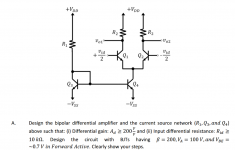The basic idea is that the signal never goes through the pot.
Has anyone tried it? The idea is simple enough. The output gain is equal to the collector resistance over the emitter resistance. Although you still need a variable resistance at the emitter, it is not in the signal path.
The complication is that in the PS Audio version uses a differential gain cell and you need two variable resistors, one for each emitter, so if you have a non-balance emitter resistance pair, the output will not be balance. In the vid, he said that they had to implement a servo feedback circuit to correct for the imbalance, which I am not quite sure how.
DIY Gain Cell volume control - YouTube
Has anyone tried it? The idea is simple enough. The output gain is equal to the collector resistance over the emitter resistance. Although you still need a variable resistance at the emitter, it is not in the signal path.
The complication is that in the PS Audio version uses a differential gain cell and you need two variable resistors, one for each emitter, so if you have a non-balance emitter resistance pair, the output will not be balance. In the vid, he said that they had to implement a servo feedback circuit to correct for the imbalance, which I am not quite sure how.
DIY Gain Cell volume control - YouTube
The resistor in the emitter _is_ in the signal path, it carries the same current as the collector,
ignoring base current...
ignoring base current...
Each component in the circuit is in the signal path. A nonlinear element at the emitter
would cause nonlinear local feedback, and distortion.
Also the voltage gain is not exactly equal to Rc/Re, that is a rule of thumb,
when 25mV/Ie is negligible compared to Re.
would cause nonlinear local feedback, and distortion.
Also the voltage gain is not exactly equal to Rc/Re, that is a rule of thumb,
when 25mV/Ie is negligible compared to Re.
Last edited:
Although it is true that the emitter resistor is part of the signal part, it is not 100% part of the signal part. But having the pot in the signal part, the pot is definitely 100% in the signal part.
Regardless of whether having the pot or not, since you will going to have the resistor at the collector and emitter anyway, why not use them as a way to control the amplitude of the output? That way you eliminate one extra thing in the signal path.
Regardless of whether having the pot or not, since you will going to have the resistor at the collector and emitter anyway, why not use them as a way to control the amplitude of the output? That way you eliminate one extra thing in the signal path.
Review and Measurements of the PS Audio Stellar Gain Cell DAC | Audio Science Review (ASR) Forum
To summarize it in one quote :
To summarize it in one quote :
The cure for potentiometer is far, far worse than the disease.
First of all, I am not sure why they have to use a "Gilbert cell" unless that is not the case. In the vid, Paul M. claims that they use something similar but not as complicated as the "Gilbert cell" but what it actually is anybody guess.
Why couldn't they use a simple diff amp and control the bias current therefore control the gain? For example in the circuit attached, you can control the gain by simply changing R1. But then at low bias current, you may run into linearity issue. So by avoiding using a pot, you do run into other problem that might be worse than what you started with.
To be fair for PS Audio, the Stellar preamp + DAC is a relative low cost unit. You get the preamp and the DAC for only 1600. A entry level PASS labs preamp is about $5.8K USD.
Why couldn't they use a simple diff amp and control the bias current therefore control the gain? For example in the circuit attached, you can control the gain by simply changing R1. But then at low bias current, you may run into linearity issue. So by avoiding using a pot, you do run into other problem that might be worse than what you started with.
To be fair for PS Audio, the Stellar preamp + DAC is a relative low cost unit. You get the preamp and the DAC for only 1600. A entry level PASS labs preamp is about $5.8K USD.
Attachments
....Why couldn't they use a simple diff amp and control the bias current therefore control the gain?...
The simple form will "thump". Unless the control signal is super slow relative to signal frequency.
There are of course improved versions. Gilbert has many. In audio, dBx was the pioneer and its brain-trust now works at THAT Corp. However the PA Audio pictures do not show THAT VCA packages. (And I do not know any other VCA product at this audio quality.) Unless what they are showing is just a 'tupperware' around a THAT.
The simple form will "thump". Unless the control signal is super slow relative to signal frequency.
Wouldn't the control signal be a DC source? I mean you could select different resistance for different gain but it is practically a DC signal which is controlling? Am I missing something?
Found a good link about this:
Using Gilbert Cell for Volume Control
Last edited:
- Home
- Source & Line
- Analog Line Level
- Conventional pot vs. PS Audio gain cell
